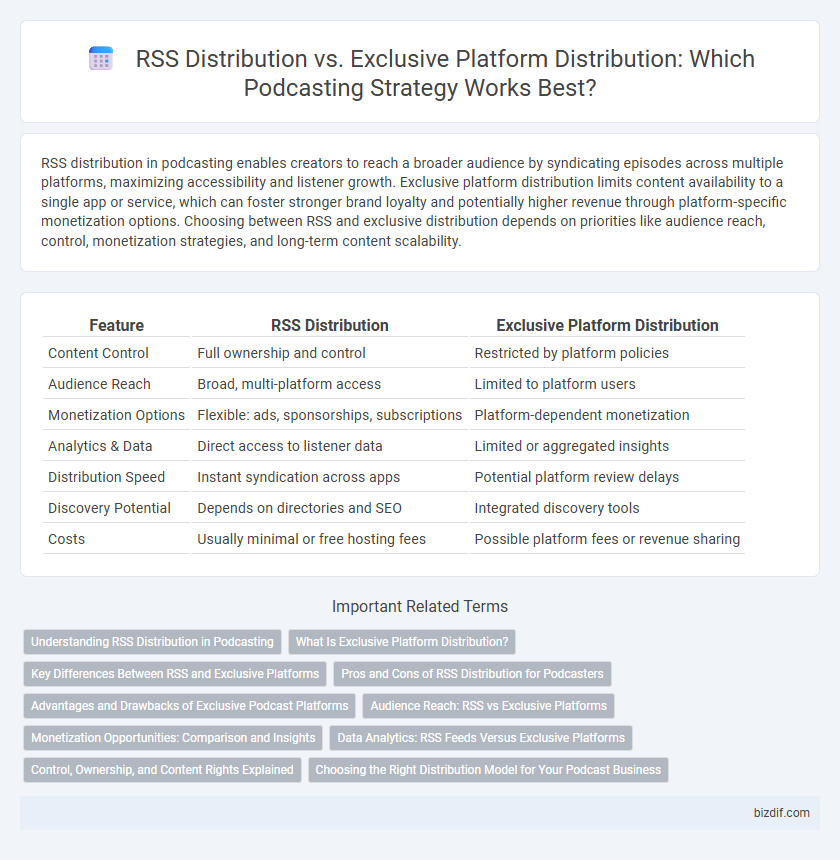RSS distribution in podcasting enables creators to reach a broader audience by syndicating episodes across multiple platforms, maximizing accessibility and listener growth. Exclusive platform distribution limits content availability to a single app or service, which can foster stronger brand loyalty and potentially higher revenue through platform-specific monetization options. Choosing between RSS and exclusive distribution depends on priorities like audience reach, control, monetization strategies, and long-term content scalability.
Table of Comparison
| Feature | RSS Distribution | Exclusive Platform Distribution |
|---|---|---|
| Content Control | Full ownership and control | Restricted by platform policies |
| Audience Reach | Broad, multi-platform access | Limited to platform users |
| Monetization Options | Flexible: ads, sponsorships, subscriptions | Platform-dependent monetization |
| Analytics & Data | Direct access to listener data | Limited or aggregated insights |
| Distribution Speed | Instant syndication across apps | Potential platform review delays |
| Discovery Potential | Depends on directories and SEO | Integrated discovery tools |
| Costs | Usually minimal or free hosting fees | Possible platform fees or revenue sharing |
Understanding RSS Distribution in Podcasting
RSS distribution in podcasting enables creators to publish episodes that automatically update subscribers across multiple platforms, ensuring wide accessibility without platform dependency. This open-standard feed format supports compatibility with various podcast apps such as Apple Podcasts, Spotify, and Google Podcasts, maximizing audience reach and discoverability. Unlike exclusive platform distribution, RSS empowers podcasters with full control over their content, metadata, and monetization strategies while maintaining ownership and flexibility.
What Is Exclusive Platform Distribution?
Exclusive platform distribution refers to the practice of making podcast content available only on a single platform or service, such as Spotify or Apple Podcasts. This strategy limits accessibility but can drive higher engagement and monetization through platform-specific features like enhanced analytics, exclusive content promotion, and direct listener support. Unlike traditional RSS distribution, which allows podcasts to be freely accessed across multiple apps and directories, exclusive distribution places content behind a controlled environment to capitalize on platform audiences and partnerships.
Key Differences Between RSS and Exclusive Platforms
RSS distribution enables podcasters to syndicate content widely across multiple platforms like Apple Podcasts and Spotify, maximizing audience reach through open accessibility. Exclusive platform distribution restricts content to a single service, offering curated audience engagement and potential monetization benefits through platform-specific features. Key differences include audience accessibility, control over content, and monetization options, making RSS ideal for broad exposure and exclusives favorable for targeted branding and revenue strategies.
Pros and Cons of RSS Distribution for Podcasters
RSS distribution empowers podcasters by providing broad audience reach through various podcast directories like Apple Podcasts and Spotify, enabling instant episode updates and ownership control of the content. However, it requires technical knowledge for setup and maintenance, may offer limited analytics compared to exclusive platforms, and faces potential challenges with content monetization and discoverability. Despite these drawbacks, RSS remains a versatile and open standard essential for independent podcast growth and audience accessibility.
Advantages and Drawbacks of Exclusive Podcast Platforms
Exclusive podcast platforms offer creators higher revenue shares and tailored audience targeting, enhancing monetization potential. However, their closed ecosystems limit podcast reach and listener accessibility compared to RSS distribution, which provides universal availability across multiple apps. Dependency on a single platform introduces risks related to algorithm changes, content control, and long-term audience retention.
Audience Reach: RSS vs Exclusive Platforms
RSS distribution enables podcasters to reach a broader audience by syndicating episodes across multiple platforms such as Apple Podcasts, Spotify, and Google Podcasts, maximizing discoverability and accessibility. Exclusive platform distribution limits podcast availability to a single network or app, potentially fostering a dedicated listener base but restricting overall audience growth and cross-platform exposure. Choosing RSS syndication typically results in higher audience reach due to the decentralized nature of content delivery and increased ease of access for diverse listeners.
Monetization Opportunities: Comparison and Insights
RSS distribution offers podcasters broad monetization opportunities through diverse ad networks, sponsorships, and listener support across multiple platforms, maximizing audience reach and revenue potential. Exclusive platform distribution often provides upfront revenue guarantees, premium ad placements, and subscription models, but limits exposure to a single ecosystem, potentially reducing overall earnings. Analyzing audience demographics, engagement stats, and platform revenue shares helps creators optimize their monetization strategy between widespread RSS syndication and exclusive platform partnerships.
Data Analytics: RSS Feeds Versus Exclusive Platforms
RSS feed distribution offers comprehensive podcast analytics by aggregating listener data from multiple apps, providing a holistic view of audience behavior and demographics. Exclusive platforms typically provide detailed but siloed data limited to their ecosystem, potentially restricting cross-platform insights and audience growth strategies. Leveraging RSS feeds enhances data accuracy and breadth, enabling more informed decisions for content optimization and targeted marketing.
Control, Ownership, and Content Rights Explained
RSS distribution offers podcasters full control over their content, maintaining ownership and rights without platform restrictions, ensuring podcasts are accessible across all directories and apps. Exclusive platform distribution often limits control, with platforms imposing content guidelines and retaining certain rights, potentially restricting audience reach and content monetization. Understanding these differences is crucial for podcasters aiming to balance audience growth with complete ownership and content control.
Choosing the Right Distribution Model for Your Podcast Business
Selecting the right distribution model for your podcast business depends on your goals for reach and revenue. RSS distribution maximizes audience exposure by syndicating your episodes across multiple platforms like Apple Podcasts, Spotify, and Google Podcasts, fostering organic growth and discoverability. Exclusive platform distribution, such as offering your podcast solely on Spotify or Patreon, can drive higher monetization opportunities and brand loyalty by leveraging platform-specific features and premium content access.
RSS Distribution vs Exclusive Platform Distribution Infographic

 bizdif.com
bizdif.com